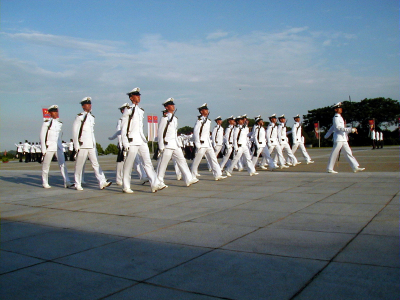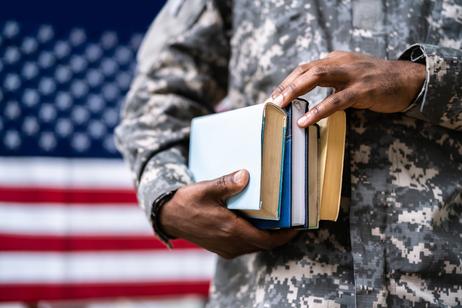All About JROTC
How did JROTC get its start?
The Junior Reserve Officers' Training Corps (JROTC) program has its roots in the National Defense Act of 1916.
- The NDA of 1916 authorized military training in secondary schools.
- Initially known as the Reserve Officers' Training Corps (ROTC), the program aimed to prepare young Americans for military service while still in high school.
- Following World War I, the ROTC underwent significant expansion. In 1919, the first high school unit was established at Manual High School in Indianapolis, Indiana.
- Over time, the program evolved to include junior-level training, leading to the establishment of the JROTC in 1964.

Photo by iStockPhotos
JROTC's primary purpose is to instill in students the values of citizenship, service to the community, personal responsibility, and a sense of accomplishment.
- While military training remains a core component, the program also emphasizes leadership development, character education, and physical fitness.
- Today, JROTC has units in over 1,700 high schools across the United States and its territories.
- These units are sponsored by the Army, Navy, Air Force, and Marine Corps and operate under the guidance of active-duty or retired military instructors.
Participation in JROTC is voluntary, and students who complete the program are not obligated to join the military.
- However, they may benefit if they enlist or pursue a commission.
- Overall, the JROTC program plays a vital role in shaping the lives of young Americans, providing them with valuable skills, leadership training, and a sense of duty to their country and community.
Here is a look at JROTC and what the program entails.
What is JROTC?
Congress established the Junior Reserve Officers Training Corps (JROTC) in 1916.
- Each branch of the services has its own distinctive JROTC program.
- However, they all have the altruistic-sounding mission "To Motivate Young People to be Better Citizens."
The U.S. Army Junior Reserve Officers' Training Corps (JROTC) is one of the world's largest character development and citizenship programs for youth. Source: JROTC
Some people think that JROTC is a recruiting program for the military. But it is not.
- Indeed, most JROTC participants do not join the military after graduating from high school.
- Nor are they required to do so.
- On the other hand, the college-level ROTC programs do require their participants to sign up for a tour of duty after graduating from college.
- Simply put, the JROTC aims to develop leadership skills in its participants, while the ROTC prepares its members for the military.
This video offers a look at Hargrave Military Academy in Chatham, Virginia.
The Branches of JROTC
The Air Force JROTC
The Air Force JROTC's comprehensive program seeks to develop academic skills, confidence, and leadership skills to equip young people to be the leaders 21st-century society needs them to be.
- Over 125,000 high schoolers are active in the Air Force program in 870 schools worldwide. Worldwide?
- Yes, worldwide, because the Department of Defense has DOD schools wherever there is a military base.
- One unique feature of the Air Force JROTC program is its Summer Flying Academy.
- This 8-week-long program offers the ability to earn a Private Pilot Certification.
- At a time when airlines need pilots, this is a solid start to a lucrative, satisfying career.
There are approximately 870 AFJROTC units with more than 125,000 cadets in high schools across the United States and selected Department of Defense Dependent Schools in Europe, the Pacific, Puerto Rico, and Guam." Source: Air Force JROTC
The Navy JROTC
The NJROTC program was established by Public Law in 1964, which may be found in Title 10, U.S. Code, Chapter 102. Source: NJROTC
As noted, Congress established the Navy's version of JROTC almost 50 years after the Army's program.
- Like its Air Force and Army cousins, the Navy JROTC program emphasizes the development of its participants.
- The Navy's JROTC summer programs vary depending on the sponsoring high school.
- Typical summer programs or "camps" include a Sail Academy, Leadership Academy, and more.
This video offers a look at Fishburne Military School in Waynesboro, Virginia.
The Marines JROTC
The effects of the Marine Corps JROTC program reach far beyond the classroom and into the community in developing character, leadership, and civic responsibility in tens of thousands of America's kids. Source: Marines JROTC
As I researched the three JROTC programs, I was struck by their unified approach to developing their young participants' leadership and academic skills.
Who teaches JROTC programs?
You might think that active-duty military personnel teach JROTC courses. But that's not the case.
- For the most part, instructors are retired military officers.
- They offer a wealth of experience and an understanding of what it means to serve the country.
- You can check out their credentials on the various schools' websites.
Valuable supplemental programs
The military JROTC programs offer young people the opportunity to explore academic programs, become part of a team, and develop an awareness of what it means to be an American citizen. JROTC programs also teach leadership skills and build confidence, all attributes that benefit young people in their adult lives.
JROTC, Junior Reserve Officer's Training Corps, is a program designed to encourage high school students to become better citizens. With an emphasis on leadership training and skills building, JROTC helps develop the "whole person" by including financial planning in the curriculum alongside wilderness survival. Source: New Mexico Military Institute
Pros and Cons
Pros
- JROTC programs are unique. In other words, the JROTC program at one high school differs from that in other schools. It all depends on the instructors, the students, and the school.
- The program costs its participants nothing. Even uniforms are provided.
- Participants have to be in good academic standing.
Cons
- Corps members have to abide by appearance standards.
- Physical training can be demanding.
Service academy nominations
Now, while JROTC programs aim to educate and develop young people instead of recruiting them for military service, young people who rise to the top of their school's JROTC program can be nominated for the prestigious military academies. Nomination to the service academies is a complicated process, with many more applicants competing for a limited number of places. Read more about the nomination process at Service Academy Nominations on the White House website.
Conclusion
JROTC programs offer valuable leadership lessons and many other attributes for high school-age young people. This quote from a military school alumnus says it eloquently:
'I love Hargrave. It taught me all about life, and some of my best years were at Hargrave. Don Haston — Alumni Source: Hargrave Military Academy
Questions? Contact us on Facebook, Instagram, and YouTube. @privateschoolreview
#jrotc #privateschools #militaryschools
























